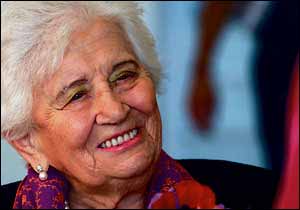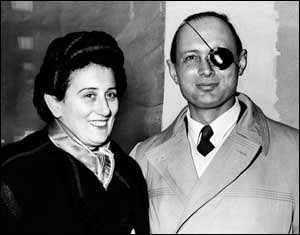|
PROFILE Life of Ruth, 100, entwined with Israel’s history | ||
The story of her life, which she describes as cinematic, is inextricably intertwined with that of the Jewish state. She was born in March, 1917 — the same year as the Balfour Declaration — in Haifa, the daughter of new immigrants from Russia, Rachel and Zvi Schwartz. Before she was two, the family decamped to London, determined to acquire new skills that would be beneficial to the Zionist dream. When they returned, Ruth was eight and could speak and write English — a rare ability at that time for a native of the region. The family built a comfortable home in Jerusalem. The neighbours called the place Schwartzland and it became a social centre of the Jerusalem elite. Ruth was sent to a youth movement and her nine-year-old sister, Reuma — who later married future president Ezer Weizman — was educated on a kibbutz. In 1934, 17-year-old Ruth dreamed of settling on a kibbutz. She prepared herself by learning the basics, such as how to milk a cow. She informed her parents that she was going to study agriculture. She arrived at Nahalal, the first moshav in British Palestine. Ruth wrote in her diary: “I came here feeling that I was entering a monastery. I’m going to stop messing with guys and wasting time on them . . . I will devote myself to work and studies in order to be a good farmer.” Ruth’s resolution to refrain from inter-gender socialising did not last long. The locals made a bonfire to welcome newcomers. Moshe provided them with an orientation. “I fell in love with him at first sight. I didn’t even know his name,” she recounted in an interview years later. “Before I arrived, I was warned by a friend, he said that the country boys over there were terrible. “Especially I was to stay away from the Dayan boys. It did not take me long to discover that who I had fallen for was a member of the Dayan family, but I deleted the warning from my memory. I was in love.” Moshe Dayan had been drafted to the Hagana paramilitary organisation at the age of 15 and was involved in clashes with the Bedouin neighbours. When they met, he was 19. She took him to meet her parents in Jerusalem — a visit, she said later, that left a deep impression on him. “Coming from a leaky hut in Nahalal with an outside toilet to an English cottage — that was something,” she said in 1986. In 1935, Ruth and Moshe married in Nahalal. Local Arab dignitaries were also invited. Ruth was only 18, yet the young couple was already involved in the complicated politics of the Middle East. The wedding served another purpose: it was a sulha (traditional dispute resolution) between the Bedouin tribes in the area and Moshe, who had fought with them regularly. The bride appeared barefoot, deliberately, but her parents provided an urbane touch. They hired a special bus for guests, brought delicacies and invited the nation’s dignitaries. The presents the couple received were bourgeois and expensive. “This made Moshe very uncomfortable,” Ruth recalled. “We finally decided that we would use the money we received to study abroad.” They went to London, but the separation from Israel was difficult and they soon returned to the Jezreel Valley. On the eve of Simchat Torah, 1939, Ruth dressed first child Yael in festive clothes. She went with the eight-month-old to the main road to welcome Moshe home from military activity with his comrades in the Hagana. Increasingly agitated, the young mother paced the empty road, but Moshe didn’t show. “Darkness descended. I returned to the hut,” she described the experience at a later stage. “I was bewildered and depressed, I wanted to kill him — Moshe — and the Hagana.” The next day the couple’s dog entered the house — alone, without Moshe. A note attached to the dog’s neck read: “We were arrested . . . I kiss you and Yael, Moshe.” He and 42 members of the underground group were arrested for illegal possession of weapons by the British, who ruled Palestine at the time, and jailed in the Acre Prison. Ruth made desperate efforts to win their freedom. She even tried to contact the Queen. Only in February, 1941, after a year and a half of imprisonment, was Moshe released.
When she saw them approaching, Ruth knew that the blissful family interlude had come to an end. The Nazis and their allies seemed to be moving inexorably toward Palestine from all directions. Vichy French forces, cooperating with the Nazis, controlled Syria and Lebanon. Dayan joined a Jewish fighting force that assisted the British. “I knew that Moshe had gone to Lebanon,” Ruth told an interviewer years ago. She was waiting for him at a kibbutz near the border. “Everyone is coming back, only Moshe has not returned. I was going crazy. I went wild. I was shouting, ‘Where is Moshe?’ But they told me nothing.” Finally, she was told to go to Haifa. “I found him completely bandaged. A bullet had hit his binoculars. It was a miracle he was alive. His response to the injury was severe, and his mood sombre. He thought it was the end of his life. ‘A person with one eye is worth nothing,’ he said.” Ruth gave birth to Udi (1942) and then Assi (1945). In 1947, Moshe was drafted again. He became an officer in charge of Arab affairs. Moshe rose through the ranks and in 1948 was appointed military commander of Jewish-controlled areas of Jerusalem. The family moved to a large villa in the city. Ruth would accompany Moshe to events and would sometimes get involved as well. In the early 1950s, many immigrants came to Israel and Ruth considered it her job to support and assist them. Ruth was unstoppable. Driving an old jeep barefoot, as was the fashion with some at the time, and armed with a gun, she travelled to the most remote and desolated ma’barot (absorption camps). She found treasures of handicrafts there. “They [the immigrants] were living in the tents, in the mud. I thought I would try to market their beautiful handicrafts,” she recalled. Ruth recognised the uniqueness of crafts from different cultures, and realised they could become a source of income for many of the new immigrants. Gradually, she began providing raw materials to the artisans, and when Moshe was appointed chief of staff in December, 1953, Ruth founded the Maskit fashion house, creating more than 2,000 jobs for new immigrants. Israel’s victory in the 1956 war turned Moshe into a world-famous figure, with his trademark eye patch. In 1967, he was appointed defence minister. “On the morning of June 6, 1967, I told Moshe I was going to Jerusalem,” Ruth said. “When I arrived, I stopped at a gas station to fill my car. As soon as I stopped, shells arriving from the direction of the Old City began falling around me.” The shells fell for another hour or two. “Finally, I managed to get Moshe on the phone and he said to me, ‘What are you doing in Jerusalem?’ I told him, ‘You did not tell me there was going to be a war there this morning’.” There were many things Moshe did not tell Ruth. The Six Day War made him a legend. Women loved him, and he did not ignore their attentions. “I accepted it,” Ruth said in an interview. “I knew who would fall at his feet, and I would answer the letters his mistresses had written to him. It was funny.” The whole country gossiped about Moshe’s affairs, and Ruth did not seem to care. “One day I went to Nablus. There were five Palestinian women in prison and I was asked if I could find them a job in Maskit. “When I got home, Moshe was already there, sitting in an armchair wearing his pajamas. I prepared his dinner. “He told me, ‘I heard in the office that you went to visit the Palestinian prisoners. I do not like the fact that I put them in prison and you go to visit them’. “At that moment I understood that we no longer thought the same way. The times were different. Our generation lived for the state; everything we did was for the state. “When I heard him speak I understood he no longer supported the idea of coexistence. I told him I wanted a divorce.” In 1972, before the Yom Kippur War, Ruth and Moshe divorced. A short time later Dayan married Rachel, a woman with whom he had been having an affair for 18 years, and who remained by his side until he died, nine years later. When Ruth’s famous ex-husband died in 1981, he left everything to Rachel. He left nothing to his children. They did not forgive him, but Ruth did. She forgave everyone. She forgave youngest son Assi, who savaged her in the newspapers. She continued to develop Maskit and worked on behalf of child welfare, the rights of Bedouin and women’s causes. She co-founded the children’s charity Variety Israel, as well as a Jewish-Arab social group, Brit Bnei Shem (Ibnaa Sam). She is a council member of human rights NGO Yesh Din and is on the board of directors of the Centre for Jewish-Arab Economic Development. Ruth recently travelled 120 kilometres to Kibbutz Ein Harod to see an exhibition called ‘Dayan – A Family Album’. She is called “granny” by a tribe of nine grandchildren and 12 great-grandchildren, who go in and out of her Tel Aviv home on a daily basis. At the age of 100, she is still capable of being excited by the design of a new Maskit dress. She feels the material. She checks the seams and looks forward to next year’s designs.
|
 FASCINATING LIFE: Ruth Dayan
FASCINATING LIFE: Ruth Dayan ICONIC: Moshe Dayan with wife Ruth on a visit to London in 1958
ICONIC: Moshe Dayan with wife Ruth on a visit to London in 1958